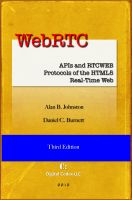WebRTC: APIs and RTCWEB Protocols of the HTML5 Real-Time Web, Third Edition by Alan B. Johnston
>> Sunday, April 27, 2014

The third edition has an enhanced demo application which now shows the use of the data channel for real-time text sent directly between browsers. Also, a full description of the browser media negotiation process including actual SDP session descriptions from Firefox and Chrome. Hints on how to use Wireshark to monitor WebRTC protocols, and example captures are also included. TURN server support for NAT and firewall traversal is also new.
This edition also features a step-by-step introduction to WebRTC, with concepts such as local media, signaling, and the Peer Connection introduced through separate runnable demos.
Written by experts involved in the standardization effort, this book contains the most up to date discussion of WebRTC standards in W3C and IETF. Packed with figures, example code, and summary tables, this book is the ultimate WebRTC reference.
Table of Contents
1 Introduction to Web Real-Time Communications
1.1 WebRTC Introduction
1.2 Multiple Media Streams in WebRTC
1.3 Multi-Party Sessions in WebRTC
1.4 WebRTC Standards
1.5 What is New in WebRTC
1.6 Important Terminology Notes
1.7 References
2 How to Use WebRTC
2.1 Setting Up a WebRTC Session
2.2 WebRTC Networking and Interworking Examples
2.3 WebRTC Pseudo-Code Example
2.4 References
3 Local Media
3.1 Media in WebRTC
3.2 Capturing Local Media
3.3 Media Selection and Control
3.4 Media Streams Example
3.5 Local Media Runnable Code Example
4 Signaling
4.1 The Role of Signaling
4.2 Signaling Transport
4.3 Signaling Protocols
4.4 Summary of Signaling Choices
4.5 Signaling Channel Runnable Code Example
4.6 References
5 Peer-to-Peer Media
5.1 WebRTC Media Flows
5.2 WebRTC and Network Address Translation (NAT)
5.3 STUN Servers
5.4 TURN Servers
5.5 Candidates
6 Peer Connection and Offer/Answer Negotiation
6.1 Peer Connections
6.2 Offer/Answer Negotiation
6.3 JavaScript Offer/Answer Control
6.4 Runnable Code Example: Peer Connection and Offer/Answer Negotiation
7 Data Channel
7.1 Introduction to the Data Channel
7.2 Using Data Channels
7.3 Data Channel Runnable Code Example
8 W3C Documents
8.1 WebRTC API Reference
8.2 WEBRTC Recommendations
8.3 WEBRTC Drafts
8.4 Related Work
8.5 References
9 NAT and Firewall Traversal
9.1 Introduction to Hole Punching
9.3 WebRTC and Firewalls
9.3.1 WebRTC Firewall Traversal
9.4 References
10 Protocols
10.1 Protocols
10.2 WebRTC Protocol Overview
10.3 References
11 IETF Documents
11.1 Request For Comments
11.2 Internet-Drafts
11.3 RTCWEB Working Group Internet-Drafts
11.4 Individual Internet-Drafts
11.5 RTCWEB Documents in Other Working Groups
11.6 References
12 IETF Related RFC Documents
12.1 Real-time Transport Protocol
12.2 Session Description Protocol
12.3 NAT Traversal RFCs
12.4 Codecs
12.5 Signaling
12.6 References
13 Security and Privacy
13.1 Browser Security Model
13.2 New WebRTC Browser Attacks
13.3 Communication Security
13.4 Identity in WebRTC
13.5 Enterprise Issues
13.6 Privacy
13.7 ZRTP over Data Channel
13.8 Summary
13.9 References
14 Implementations and Uses
14.1 Browsers
14.2 Other Use Cases
14.3 STUN and TURN Server Implementations
14.4 References
INDEX
ABOUT THE AUTHORS
Dr. Alan B. Johnston has over thirteen years of experience in SIP, VoIP (Voice over IP), and Internet Communications, having been a co-author of the SIP specification and a dozen other IETF RFCs, including the ZRTP media security protocol. He is the author of four best selling technical books on Internet Communications, SIP, and security, and a technothriller novel “Counting from Zero” that teaches the basics of Internet and computer security. He is on the board of directors of the SIP Forum. He holds Bachelors and Ph.D. degrees in electrical engineering. Alan is an active participant in the IETF RTCWEB working group. He is currently a Distinguished Engineer at Avaya, Inc. and an Adjunct Instructor at Washington University in St Louis. He owns and rides a number of motorcycles, and enjoys mentoring a robotics team.
Price: $9.99 USD
First 20% Sample: epub | mobi (Kindle) | lrf




0 comments:
Post a Comment